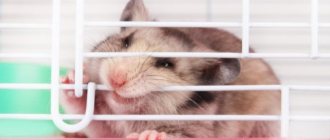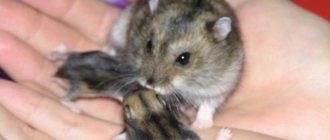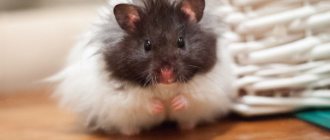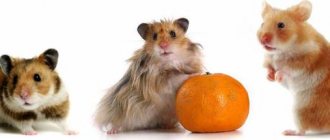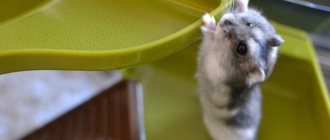How to distinguish a dwarf hamster from a Campbell's hamster? Hello, dear friends. Of course, you know that in nature there are many different hamsters: Djungarians, Syrians, Roborovsky, Campbell and other rarer species. However, some dwarf hamsters have a striking resemblance to each other. It is not uncommon for inexperienced sellers in pet stores to confuse dwarfs and Campbell's hamsters, misinforming customers from the very beginning about which pet they have chosen. Of course, it is very important to know what kind of rodent you are buying in order to have an objective idea about the characteristics of its health, character, nutrition, taming and much more. Therefore, today I invite you to discuss how to distinguish a dwarf from a Campbell's hamster. Both named species (Djungarians and Campbells) belong to dwarf hamsters. We have already talked to you about the existing colors of Djungarian hamsters. The simplest thing is to match your pet's color to the standard, pearl, tangerine or sapphire color. If the rodent's fur coat looks different from the colors listed, then it is likely that this is a Campbell's hamster and not a dwarf hamster. In addition, quite often in pet stores you can find hybrids that contain the features of these 2 types of hamsters. What features will help distinguish a dwarf from a Campbell's hamster? As a rule, difficulties arise when determining the type of hamster with a natural (standard) color. What is important to pay attention to? 1. The colors of Djungarian hamsters are dominated by black, dark brown and gray colors, while those of Campbell's hamsters are dominated by brown, sand and amber (they are characterized by a certain reddishness). 2. The stripe on the back of the dwarf is wider and more distinct than that of the Campbells. It smoothly flows onto the hamster’s head, forming a diamond shape on its face. 3. The fur coat of dzhungarikas is quite dense, it lies flat and does not puff up. Campbell's hamsters, on the other hand, have fur that grows at an upward angle and sticks out a little, looking rather ragged. 4. When transitioning from the back to the stomach, arches are clearly visible in Djungarians, while in Campbells these arches are less noticeable or absent altogether. 5. If you look at the hamster from above, the Campbell will resemble the shape of a figure eight, and the Dzhungarik will resemble eggs (thicker in the butt, but narrower towards the muzzle). 6. If you see that the rodent’s eyes are red, it’s definitely not a dwarf. At the same time, some colors of Campbell's hamsters allow the pet to have red eyes.
Biological characteristics
If you come to the pet store unprepared, you can easily run into problems when, instead of one type of hamster, they slip you another. It’s even worse if you take one dzhungarik, and along with it they sell you Campbell as a pair. Under no circumstances should these species be crossed. And to avoid such problems, it is worth turning to biological signs.
Both species belong to the rodents and the genus Hairfoot. Both hamsters have approximately the same size - up to 10 centimeters in length, and weigh about 70-80 grams. However, it is believed that the Campbell's hamster is a miniature dwarf hamster; its parameters in the classic form differ slightly to a lesser extent.
Both the dwarf and the Campbell's are primarily nocturnal. Hamsters feed on grain crops and dried seeds, mainly pumpkin seeds.
Hamsters love to hide in holes, so there are always secret places in their house where they climb and where they store food supplies. Animals breed in captivity throughout the year; a female can give birth to up to 10 babies at a time. By the way, Djungarians bear offspring from 20 to 25 days, but Campbells carry offspring from 18 to 22 days.
Campbell's Hamster Reproduction
Having gotten used to their new place of residence, Campbell's hamsters are ready to breed. The most favorable period for mating is March – September. In winter, animals are not so active. Pregnancy lasts from 18 to 20 days. There can be about 8 cubs in one litter, although in some cases the female can give birth to more offspring.
Babies are born naked and blind. Soft fur begins to cover their body only on the fifth day of life. After 10 days, little Campbells are completely ready for independent life.
How to distinguish a Djungarian hamster from a Campbell's hamster
Djungarians have a variety of colors, often their fur has several shades from gray-brown to white. An important distinguishing feature is wide stripes on the sides, a stripe on the back, and a diamond on the top of the head.
Campbell's coloration becomes more reddish, and a clear black stripe stretches along the back. They have virtually no markings on the sides and top of their heads.
The colors that are observed in the dzhungarik are: peach, tangerine, fawn, pearl, bluish-gray, sapphire. Campbell tends to have reddish tones that fade into camel or taupe. Among these species there are also albinos. There are also colors ranging from chocolate to beige-blue, platinum and even spotted. There are also completely black individuals.
Important: Campbell's hamsters, unlike dwarf hamsters, do not change their color in winter. In Djungarians, the stripe on the back practically disappears by winter.
The Campbell's hamster has a smoother body with a pronounced waist, but the Djungarian hamster is shaped like a flattened egg. The Campbell's hamster is also more miniature, it weighs less, and also does not have such a massive body as its Djungarian relative.
You can distinguish hamsters by their behavior. Camps are always calm, a little shy, but quickly get used to being handled. But the dzungarians have a rather aggressive character at first; in the first days they can bite and will try to escape and hide in a secluded place. But after a couple of weeks, hamsters quickly get used to hands and are not afraid of either children or adults.
By the way, it is important to understand that the character of hamsters is formed in the pet store. If they are too nervous, twitchy, fearful or aggressive even a month after purchase, this means that their mental state has noticeably deteriorated. And in order to restore calm to the hamster, you will have to tinker for more than one day.
Campbell's and Djungarians have regular dark beady eyes. Sometimes there are albinos among the Camps, and their eyes turn red. But in Djungarians this feature is not observed, so the variety can be determined by this characteristic.
Who is better as a pet?
This issue can only be resolved through personal preference. If you like activity, constant movement, if your children want to play with a hamster, then choose a hamster. If you want a cute, calm, sometimes sleepy and apathetic animal, then Campbell is best for you. It is worth remembering that a crossbreed is usually a problem hamster; it gets sick, can show uncontrollable aggression, and also have a number of mutations.
Purchase rules and price
Remember a few purchasing rules:
- The pet store must be clean and have animal certificates.
- The seller must show you the specimens. They should not have dirt in their ears, bruises in their ears, their eyes should be clean and shiny, their fur should be smooth and silky.
- The price of hamsters should not be too low. On average, you can pay from 500 to 2000 rubles for an individual. Sometimes they are sold together with a cage and various accessories - a drinking bowl, a bowl and a wheel.
Characteristics of Campbell's hamster
The habitat of these animals is Mongolia, northern China, Kazakhstan and Russia.
They got their name in honor of the man who discovered this species and first showed it to the world - Charles Campbell.
The length of the body including the head varies from 7.5 to 10.5 cm, weight is about 23-26 g. The head is round, the muzzle is short and sharp. The eyes are red.
The coat color comes in 2 main colors - agouti (the top layer of the coat is dark, gradually lightens towards the tips, there is a dark stripe along the back, there are also stripes on the sides that separate the back from the belly, white) and self (uniform color, there is no stripe on the back, sometimes there are spots on the abdomen or chest).
Campbell's hamsters live on average 12-18 months.
With proper care they can live up to 2 years.
These animals are not distinguished by their docile nature: they often bite their owners and rarely go into their hands voluntarily.
A cute, cheerful, small and very playful fatty is a Campbell's hamster
Comparative characteristics of the Roborovskiy and Djungarian hamsters
| Djungarian hamsters | Roborovsky hamsters | |
| 1 | They reproduce very well | They do not reproduce so easily, there are from 3 to 6 babies in the litter |
| 2 | The back is decorated with a wide stripe, a diamond is clearly “drawn” on the head | There is no stripe. Usually have a grayish-brown color and a white belly, white “eyebrows” |
| 3 | Very small tail | The tail is not visible at all, it is hidden in the fur |
| 4 | Cannot stand proximity to others like themselves | More friendly to their relatives, sometimes can be kept in a same-sex group |
| 5 | Sociable, make contact with people, need them | Live their own lives, almost impossible to tame, wild and timid |
| 6 | Standard life is about 2 years | Live up to 3.5, sometimes up to 4 years |
| 7 | A good choice for a child of primary school age | Not suitable for small children: very mobile, easily jumps out of hands |
| 8 | Can be kept in standard rodent cages | Plastic or glass containers are suitable for keeping, as animals can squeeze through the bars |
| 9 | Rarely bite | They are not inclined to bite, and at the same time, they are the only ones of all their relatives that are not able to injure human skin with their teeth. |
| 10 | Easy to buy, not uncommon | Not so common |
| 11 | Inexpensive | The cost of the animal can be an order of magnitude higher than the price of the jungarik |
| 12 | Sharp muzzle | Snub muzzle |
How much does a Roborovsky hamster cost?
In terms of price, the Roborovsky hamster differs from its counterparts to a greater extent. They are rarer and more difficult to breed. The cost of one animal ranges from 1000 to 2000 rubles. You can buy cheaper, up to 500 rubles, but this is not worth doing on the market. There are nurseries that breed these babies.
When purchasing from competent breeders, you receive documents for the animal and guarantees based on gender and age.
How many animals should I get?
It's fun to keep a couple of animals. They have a very busy life, they are energetic and active. Two females or two males are suitable for living together in the same territory. It is better if these are relatives who grew up together. A fight may occur between other animals. Sometimes they can be kept in a group of the same sex, but this is not advisable.
It is unacceptable to put two males and a female in one cage; there will be a brutal fight.
When purchasing a mixed-sex pair, the animals must be kept separately. To obtain offspring, you can plant them together only for the duration of mating. You should not immediately combine animals in the same room. Place the cages side by side or separate them with a partition, let the animals get to know each other and sniff each other.
How long does a Roborovsky hamster live?
These animals are less domesticated; they have retained their natural resistance to disease. Their lifespan in good conditions can reach 4 years, which is rare for other breeds.
The mobility of babies requires sufficient space. You will delight them with a large number of tunnels and running devices. Houses, burrows, and a running wheel are a guarantee that the animals will feel comfortable. The wheel must be monolithic so as not to damage the small legs that may get stuck in the crack of the movable structure.
Features of the breed
In captivity, the Roborovsky hamster is susceptible to stress.
He does not like hands and practically does not need human contact, he easily panics.
The animal must be protected from external noise and sharp sounds, especially in the first days of being in a new place.
You should not remove it from the terrarium or cage. He will be uncomfortable and can easily run away. You can catch it by placing traps with your favorite treat in places where it moves.
This breed is the most interesting to watch. The animal is very active in the evening and at night and is distinguished by a variety of social relationships in the group.
Animal food and cage
The animal needs a room with an area of 70x50 cm; if there are two kids, each needs a shelter and a separate running wheel. The size of the wheel is approximately 18 cm. Sprinkle the floor with sand 2-3 cm, put a drinking bowl, feeder, and mineral stone. Twigs, moss and anything that can serve as a shelter for babies will provide them with comfort.
If the hamsters are calm enough, you can carefully train them to use the toilet by placing a tray with litter in the cage; only children can be trained.
The animals' diet is standard and meets the needs of other breeds. Animals eat:
- grain mixtures;
- vegetables;
- fruits;
- greens (except spicy);
- sprouted wheat,
- millet.
Children consume protein foods in the form of eggs, cottage cheese, cereals, fish, and mealworms. You can give good quality chicken meat. This food is especially needed by pregnant females.
Do not feed animals table food, canned food, herbs, spoiled or processed foods.
Reproduction
To breed Roborovsky hamsters you need to know the following:
- A couple should be brought together at the age of 4 months;
- Pregnancy in females occurs on the first day and lasts 22-24 days;
- labor lasts about 2 hours;
- the pregnant female is removed and not disturbed;
- the animal that has given birth becomes aggressive, do not touch the children, stop cleaning the cage for a while;
- children are born blind, deaf and bald and weigh 1 g, body length 1 cm;
- If necessary, babies are fed bread soaked in milk, steamed with millet or buckwheat, and clover; a little later, protein foods and sprouted grains are added;
- family separation is carried out after 23 days from the date of birth. Remember! You cannot touch babies with your hands or leave your scent on them. The mother delivers food to them herself, and a baby that has fallen out of the nest can be corrected with a spoon or tweezers.
This breed is interesting for its natural habits of a not fully domesticated creature. It will not serve as a toy, but will open you up to the wonderful world of wildlife.
Roborovsky hamsters are the smallest and most unusual 5 (100%) 8 votes
Conditions of detention
Due to their restive nature, these hamsters prefer to live alone. A high level of sense of independence gives rise to their conflict, so when kept together, rodents will constantly experience stress.
The cage size for one animal must be at least 50x30 cm.
Campbell's hamsters are especially active in the evening and at night.
For bedding in the cage, dry shavings (not coniferous trees, as they are harmful to the lungs) or ready-made corn filler are perfect. Animals make nests; to do this, they must be provided with unscented white napkins. Cotton wool should not be given to rodents; their paws can get tangled and damaged. Various pipes, ladders, labyrinths and a solid wheel with a diameter of at least 15 cm are required. To grind down the animal’s teeth, it is necessary to provide branches of deciduous trees.
You should not change the filler in the cage every day; hamsters are sensitive to their housing and this can cause them stress.
It is recommended to change the filler every 5-7 days. You also need to make sure that there is no spoiled food in the cage and there is always clean water. You cannot change the initial position of feeders, toys, or wheels.
Before sunrise, the animals go to bed
The optimal temperature for these animals is 20-25 degrees.
According to many breeders, Campbells often bite and are reluctant to be handled by their owners. This is not only a distinctive feature of the breed, but also the result of various actions on the part of the owner, for example, sudden movement or screaming, or the lack of objects for grinding teeth.
You cannot take your pet by the scruff of the neck, only from below or from the side. The ideal option is to put your hand next to him so that he climbs into it himself.
You can only gain the affection of a Campbell hamster through an affectionate attitude: treat him with something tasty, speak to him in a calm tone, stroke him gently and carefully.
Color
The first thing you should pay attention to when purchasing a small rodent is the color of its coat. Let's look at every detail of the color that helps determine the breed of the rodent.
- Dzhungarik's wool is colored in dark shades of brown, black and gray. The fur of its dwarf relative is colored in sand and amber shades; there are also black representatives of the species. If Djungarian hamsters are dark brown, the Campbell hamster has light shades of brown.
- In 99% of cases, Dzungarik has a diamond on his head. Depending on the color of the coat, it can be clearly outlined or almost merge with the main color of the coat. It is most clearly drawn on the head of brown rodents. In gray animals it is barely visible.
- Look at your pet's sides. Dzungariks have clearly defined arches between their back and stomach. The Campbells also have them, but their outlines are not so pronounced. They practically merge with the main color of the coat.
- The last thing to notice is the stripe on the back of the pygmy rodent. It is present in both breeds, but in Dzungariks it has clear boundaries, and it is also quite wide in the withers area. The Campbell's hamster has a thin dorsal stripe, almost invisible in the lower part of the body.
Campbell rodents come in a wider variety of colors. Among the pets there are albinos, animals with Argentine and Agouti colors, spotted and gray rodents, etc.
Summarizing
We looked at how to distinguish a Campbell's hamster from a Dzungarik. But it is worth remembering: sometimes small rodents do not meet the standards of any breed. This means that the animal was born as a result of crossing representatives of different breeds. If you like just such a rodent, you should not refuse to buy it because it does not meet the breed standard. As practice shows, rodents obtained by crossing two breeds produce interesting coat colors.
As for character, such representatives take the best from their parents. The only drawback of non-purebred rodents is that they are highly discouraged from being used for crossing. Often the offspring from such parents are not viable or have serious health problems.
Campbell's hamster (left) and Djungarian hamster (right)
Decorative and cute hamsters are one of the most common pets. They do not take up much space, do not need walking, and are also very interesting to watch. Many lovers of these rodents, before choosing a pet, wonder how to distinguish a Campbell's hamster from a dwarf hamster, and which of them is better to buy as a pet.
Description of the breed
Campbell is a member of the dwarf hamster family. Outwardly, it is very similar to the Djungarian, so many people ask the question: “How to distinguish the Djungarian from the Campbell's hamster?”
In fact, this species has its own distinctive features. Campbell has small ears and golden brown fur. Djungarian hamsters are lighter in color. A characteristic feature of representatives of both breeds is a dark stripe that runs along the back along the body.
Campbell's hamster does not have hair on the soles of its feet. Another specific feature of this pet is the relative difficulty of keeping it, or rather, taming it. The fact is that the Campbell hamster is a very biting breed. Therefore, it is impossible to keep several representatives of the rodent family in one cage.
Djungarian hamster and Campbell's hamster: biological characteristics
Both species of these small rodents belong to the genus Hairy Hamsters. They can mate with each other, which is why you can often find hybrids in pet stores. Both species are small in size: from 7 to 10 cm in length. The weight of an adult animal is no more than 65-70 grams. These animals are predominantly nocturnal.
Due to their size, both the Djungarian hamster and its dwarf relative can live in small cages, aquariums or plastic terrariums. They are kept one at a time, and sawdust or shavings must be poured onto the floor. The basis of the menu of both types is grain mixtures, dried corn cobs, pumpkin seeds.
The animals live in deep burrows. It usually has 4-5 inputs. Each of them leads to its own “department”. The hamster's home has separate chambers for eating and resting. The animals breed from March-April to October (in captivity they can mate and give birth throughout the year). In one litter, the female brings up to 11 babies.
There is a difference in the duration of pregnancy: Djungarians bear offspring for 21-26 days, and Campbells - 18-22 days.
Despite the fact that the animals of both species are very similar to each other, there are signs that allow you to distinguish the dzhungarik from the Campbell:
Coat type
Djungarians have denser fur, fit well to the body, and appear smooth and shiny. Campbell's hairs are slightly wavy, which gives the animal a slightly tousled appearance.
Djungarian hamsters can have several different colors, but they are all united by one feature: wide stripes on the sides and a “belt” along the back, and on the face it forms a brightly defined diamond. Campbells are more red, they are usually evenly colored, there is a thin black stripe along the back, but there is none on the sides. The coat colors are as follows: standard, tangerine, pearl (can also be tangerine or blue), camel (blue tangerine) and pearl camel, sapphire.
Differences between the Djungarian hamster and Campbell's
Campbell hamsters also come in a variety of colors. The most common is agouti. There are also colors: albino, opal, argenta (with red and black eyes), black, fawn (lilac or blue), dove, blue, chocolate, lilac, beige blue or dark, spotted, platinum.
Campbell's hamsters, unlike dwarf hamsters, do not change their color in the cold season. In dungarian hamsters, when they change to a winter coat, the stripe on the back can practically disappear, especially in light-colored hamsters.
Campbell's hamster has a waist. Its body slightly resembles the number 8. The Djungarians have a more rounded body, shaped like an egg.
Ears
The Campbell's hamster has smaller ears than the dwarf hamster.
The owners note that the Campbell, unlike the Djungarian, is a more aggressive and unsociable animal. They don't really like to sit on your hands and can bite. The Dzungarik has a fairly friendly character, is quite tamed, and is more willing to make contact.
Campbell's hamster
Feeding and diet
The basis of this animal's daily diet is cereals. You can buy ready-made food in pet stores. You can make the mixture at home by mixing equal parts of peas, corn, wheat, nuts, sunflower and pumpkin seeds.
You can feed your hamster any fruits, vegetables and nuts.
Prohibited:
- citrus;
- persimmon;
- garlic;
- onion;
- potato;
- zucchini;
- almond;
- peanut;
- fruit seeds and pits.
You can add parsley, dill, clover, and lettuce to your diet.
Dried fruits and biscuits can serve as treats.
The diet should be enriched with greens - parsley, dill, clover
In order to diversify your pet’s diet, make it more complete and balanced, it is recommended to give your hamster:
- bread;
- cottage cheese;
- unsalted wheat, semolina or oatmeal porridge;
- boiled meat.
Campbell's hamsters turn over their food bowl, so you need to make sure there is always fresh food in it.
But you shouldn’t give too much food, excess weight will negatively affect your health.
The water needs to be changed every 1-2 days. At the same time, the drinking bowl can only be washed using soda, without detergents.
Which hamster is best as a pet?
Both species lead an active nocturnal lifestyle. They happily rummage through the bedding, run on the wheel, and rustle food in the bowl. The owners of these animals note that Djungarian hamsters are more suitable as a pet, as they are usually friendlier, easier to tame, and like to fall asleep in their arms.
Campbells, on the other hand, are more aggressive. They love to show their difficult temperament and bite their fingers hard. Some representatives of the species have to be handled using special leather gloves.
However, despite such differences in character, there are exceptions in each species. Djungarians can also be aggressive, but some representatives of the Campbells, on the contrary, will be very affectionate and tame.
Representatives of any type of hamster do not live long - only 2-3 years. Each owner must provide the necessary conditions for their pet. These animals are quite tamed, so if you have patience and tasty treats, you can tame not only the peace-loving Dzungarians, but also the more obstinate Campbells.
What is the difference between a Djungarian hamster and a Campbell's hamster 4.5 (89.09%) 11 votes
Hamsters and dwarfs difference
